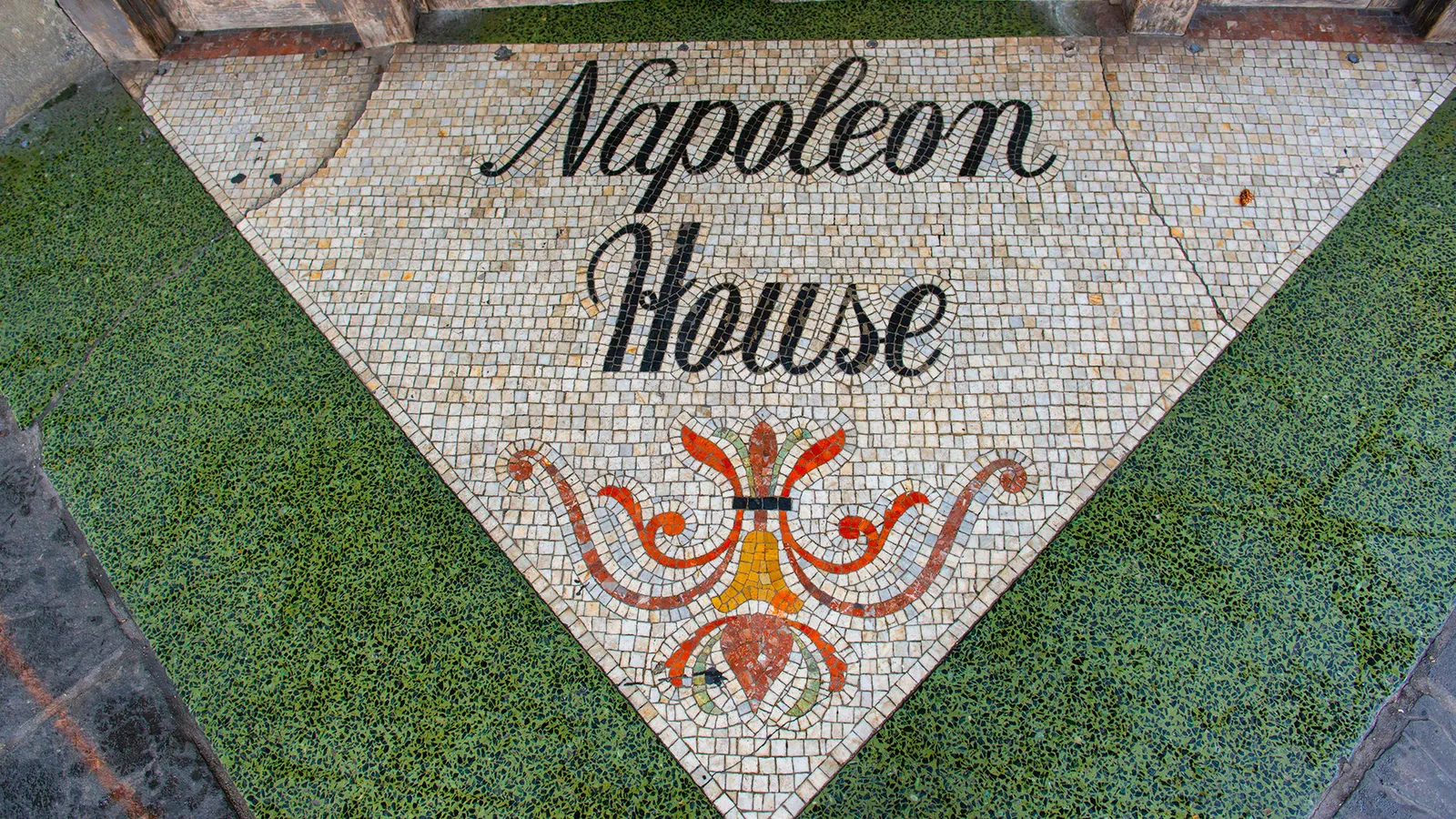The New Orleans landmark that almost became Napoleon's retirement home
It doesn't appear in textbooks and isn't included in the much-anticipated movie Napoleon – but the French politician had bold plans to start a new life in the US

In the interior garden courtyard of Napoleon House, a warm breeze murmured over wrought-iron bistro tables. It swelled, turning the hum of conversation and clinking of silverware into a quiet symphony. Bow-tied waiters glided between tables at the New Orleans restaurant, depositing the signature Pimm's cup cocktail, Creole classics like jambalaya and red beans and rice, and Italian muffalettas stacked high with sliced meat, cheese and piquant giardiniera.
This beacon of casual yet high-style dining is visited by thousands of people each year both for its food and history. Built in 1815, the Creole "cottage" is one of the city's nine original structures, and still retains many of its 19th-Century hallmarks, from the uneven floors to old-growth pine plank ceilings.
If you closed your eyes, you might be swept back in time to when the city, settled by the French in 1718 and still celebrating its greatest land victory against the British in the War of 1812, was populated by Francophone expats enamoured with the brilliant politician Napoleon Bonaparte, who revolutionised government and social programmes in France.
You might even hear hushed conversations about secreting the banished dictator to American shores, to a hero's welcome, where he would live out his retirement – a bit of history that doesn't appear in textbooks and isn't included in the action opus Napoleon by BAFTA-winning spectacle specialist Ridley Scott that rides into cinemas on 22 November 2023.
And although Napoleon never ended up making it to the US, travellers to New Orleans can still see glimpses of infamous dictator's fascinating connection to the city and learn more about his thwarted desire to start a new life Stateside.
The end of a dictator
After skyrocketing through French military ranks during the decade-long French Revolution, which began in 1789, Napoleon rose to First Consul of France in 1799 and emperor in 1804 by "pursuing a policy that we might find familiar today: making France great again", said Alexander Mikaberidze, history professor at Louisiana State University‒Shreveport and author of The Napoleonic Wars: A Global History.
Napoleon was crowned emperor in 1804. Subsequent victories at Austerlitz in 1805, Jena and Auerstedt in 1806 and Eylau and Friedland in 1807 granted France power over most of Europe. But the dictator's plans didn't stop on the eastern side of the Atlantic. Mikaberidze explained, "North America featured prominently in Napoleon's plans from early on as he sought to revive the colonial empire France lost during the Seven Years War."
France had ceded Louisiana to Spain in 1762, but Napoleon negotiated with King Carlos IV in 1801 to regain it. Head to the Historic New Orleans Collection in the French Quarter to see original correspondence on the retrocession of Louisiana from Spain to France.
A piece of the New World was key: the Louisiana Territory, an 828,000-square-mile tract of land that included not just Louisiana itself, but the modern-day states of Arkansas, Iowa, Kansas, Missouri, Montana, Nebraska, North and South Dakota and Oklahoma, as well as parts of Colorado, Minnesota and Wyoming. The territory was a vital area for resupplying and sheltering troops deployed in the valuable "sugar islands" of the Caribbean, especially Saint-Domingue (modern-day Haiti).
In 1801, an uprising of the enslaved people on Saint-Domingue resulted in an embarrassing loss for France. Having ceded control of the island, Napoleon opted to sell the Louisiana Territory to America – a solution he found more palatable than allowing the land to fall into the hands of his sworn enemy, the British.
For their part, the Americans had planned on acquiring only New Orleans, a crucial gateway to the seas. During negotiations, Napoleon offered them the entire territory – almost all of it still owned and occupied by Indigenous tribes – for $11,250,000, or less than 3 cents per acre. America assumed control of the land in May 1803, doubling the area of the nascent country and strengthening its strategic position practically overnight.
Global wars converge
By the early 1800s, New Orleans had thousands of French immigrants – and Bonaparte loyalists. "There was basically a cult of Napoleon at this time," said Karen Leathem, historian at the Louisiana State Museum.
There was basically a cult of Napoleon at this time
Among them was Nicolas Girod. Born in the Duchy of Savoy, a portion of north-western Italy annexed by France, Girod arrived in New Orleans while it was under Spanish colonial rule (1763-1803). A tavern keeper and smuggler before eventually working his way up to become a successful commission merchant, Girod was elected mayor of New Orleans in 1812.
Newly wealthy, Girod purchased several properties in what is now known as the French Quarter. In 1814, on Chartres Street, he commissioned a grand home – the place now known as Napoleon House. The bottom floor, which opened directly onto the street via casement doors, was used for business. Living spaces were located on the second and third floors. At the top, Girod built an octagonal cupola from which he could observe the comings and goings in the port of New Orleans.
By then, Napoleon's fortunes had turned. Following the disastrous invasion of Russia in 1812, Napoleon was defeated in 1813 by a coalition of Britain, Russia, Austria, Prussia and Sweden. He abdicated a year later and was exiled to the Italian island of Elba only to escape nine months later and reclaim his title.
Napoleon's return galvanised old enemies. They clashed again in Belgium, where Napoleon was eventually defeated in the brutal Battle of Waterloo.
According to Louis Antoine Fauvelet de Bourrienne's Memoirs of Napoleon Bonaparte, in 1815 Napoleon confided in friend Antoine Marie Chamans, the Comte de Lavallette, "If they do not like me to remain in France, where am I to go? To England? My abode there would be ridiculous or disquieting… America would be more suitable; I could live there with dignity."
Correspondence between Napoleon's younger brother Lucien Bonaparte and Emmanuel-Augustin-Dieudonné-Joseph, Comte de Las Cases, shows that Napoleon's initial plan was to retire on the shores of the Mississippi or Ohio rivers. Upon learning his brother Joseph had beaten him to American shores, he said, "If I were in his place, within a year I would create a great empire in the Spanish Americas."
Lavallette dissuaded the dictator, citing the example of General Jean-Victor Moreau, a French revolutionary-turned-Napoleon detractor who had retired in the United States, only to join the Allied cause against France. Napoleon still dreamed of emigrating to America, however, and instructed his staff to start packing books from his vast library for shipment. According to Mikhaberidze, he was spotted reading books about the Americas, and, during a conversation with famed botanist and traveller Aime Bonpland, invited the author to visit him Stateside.
Napoleon requested that France's Provisional Government prepare a frigate on which he could embark for his retirement in America. The written order to the ship's captain never arrived, and Napoleon made it only as far as the central western coast of France. After several days spent trying to commission various captains to convey him to the United States, he was captured by the English and exiled a second time, to the heavily guarded island of Saint Helena in the South Atlantic.
There were Bonapartist exiles in New Orleans, most of them diehard supporters of Napoleon. They believed that if given an opportunity, they should rescue him
In America, whispers began to spread. "There were Bonapartist exiles in New Orleans, most of them diehard supporters of Napoleon," explained Mikaberidze. "They believed that if given an opportunity, they should rescue him." Likewise, Napoleon believed the Bonapartist enclave in the Spanish colonies of America would attract talented and ambitious people from across the world, who would help rise against Spain and found a "new homeland".
Among the grand schemes were building a submarine or sending a flotilla of pirates to liberate the former emperor. Dominique You, a New Orleans‒based privateer and frequent collaborator of famed pirate Jean Lafitte, was said to have organised a group that would cross the ocean on the yacht Seraphine – an expedition financed by Girod, who was believed to have offered his third-floor apartments to the exiled dictator. Before You could make the trip, Napoleon died in 1821 from stomach cancer.
The Napoleonic legacy in The Big Easy
Remnants of the Napoleonic past exist all around New Orleans. Leathem explained, "Pierre-Benjamin Buisson, a French surveyor who fought as an artillery captain under Napoleon, laid out the neighbourhood around a central street he called Napoleon Avenue. There are streets named Marengo, Milan, Jena, Austerlitz, after some of Napoleon's great victories."
The Historic New Orleans Collection has a number of objects related to Napoleon; as well as correspondence on the retrocession of Louisiana from Spain to France, you can also see miniature portraits of the emperor and his beloved wife, Josephine.
The Louisiana State Museum has an embroidered bee from Napoleon's coronation gown, as well as a bronze death mask – one of nine cast from the original plaster – made by the dictator's physician, Dr Francesco Antommarchi, and gifted to the city in 1834.
Louisiana State University‒Shreveport's collection contains hundreds of volumes on Napoleon and a large number of caricatures, including an almost complete portfolio by British political commentator George Cruikshank.
And there's Napoleon House, a National Historic Landmark. Within its patinaed walls it preserves 200 years of history, from its French Creole beginnings to its early-1900s transformation into an Italian grocery and modern iteration as a restaurant and bar.
General manager and executive chef Chris Montero, an avowed history buff, delights in visitors' discovery of the building. "Professors bring architectural students from all over the world," he said. "Most of the historic architecture in New Orleans is post-Civil War. Very little of this original French Creole style exists intact." He frequently leads tours of the property, including the suspected slave quarters tucked under the top-floor dormers, and the cupola, which provides some of the best views over the city.
As the restaurant – and the upcoming movie – demonstrate, our fascination with Napoleon endures.
According to Mikaberidze, this is because of his many progressive reforms on which modern France is based: administrative, judicial and educational systems; the Bank of France; national archives; public treasury; and stock exchange, to name a few.
But there's the darker side. "What do we do with a man who, on one hand, accepted revolutionary principles of civil equality and equality of opportunity, but also sought to restore slavery? A man who presided over a prototype of a police state? For over a decade, he was an unstoppable force of change. Now it's up to us to decide whether that change was necessarily good or bad," Mikaberidze said.
-bbc







